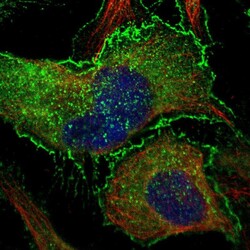Antibody data
- Antibody Data
- Antigen structure
- References [9]
- Comments [0]
- Validations
- Immunocytochemistry [1]
Submit
Validation data
Reference
Comment
Report error
- Product number
- HPA023310 - Provider product page

- Provider
- Atlas Antibodies
- Proper citation
- Atlas Antibodies Cat#HPA023310, RRID:AB_1845264
- Product name
- Anti-BAIAP2
- Antibody type
- Polyclonal
- Description
- Polyclonal Antibody against Human BAIAP2, Gene description: BAI1-associated protein 2, Alternative Gene Names: BAP2, Validated applications: ICC, IHC, WB, Uniprot ID: Q9UQB8, Storage: Store at +4°C for short term storage. Long time storage is recommended at -20°C.
- Reactivity
- Human, Rat
- Host
- Rabbit
- Conjugate
- Unconjugated
- Isotype
- IgG
- Vial size
- 100 µl
- Concentration
- 0.2 mg/ml
- Storage
- Store at +4°C for short term storage. Long time storage is recommended at -20°C.
- Handling
- The antibody solution should be gently mixed before use.
Submitted references BIN1 regulates actin-membrane interactions during IRSp53-dependent filopodia formation.
Tunnelling nanotube formation is driven by Eps8/IRSp53‐dependent linear actin polymerization
A mechanosensing mechanism controls plasma membrane shape homeostasis at the nanoscale
Adult re-expression of IRSp53 rescues NMDA receptor function and social behavior in IRSp53-mutant mice
Dendrite tapering actuates a self-organizing signaling circuit for stochastic filopodia initiation in neurons.
Initiation and disassembly of filopodia tip complexes containing VASP and lamellipodin
IRSp53 Deletion in Glutamatergic and GABAergic Neurons and in Male and Female Mice Leads to Distinct Electrophysiological and Behavioral Phenotypes
IRSp53 controls plasma membrane shape and polarized transport at the nascent lumen in epithelial tubules
Redundant functions of I-BAR family members, IRSp53 and IRTKS, are essential for embryonic development
Picas L, André-Arpin C, Comunale F, Bousquet H, Tsai FC, Rico F, Maiuri P, Pernier J, Bodin S, Nicot AS, Laporte J, Bassereau P, Goud B, Gauthier-Rouvière C, Miserey S
Communications biology 2024 May 9;7(1):549
Communications biology 2024 May 9;7(1):549
Tunnelling nanotube formation is driven by Eps8/IRSp53‐dependent linear actin polymerization
Henderson J, Ljubojevic N, Belian S, Chaze T, Castaneda D, Battistella A, Giai Gianetto Q, Matondo M, Descroix S, Bassereau P, Zurzolo C
The EMBO Journal 2023;42(24)
The EMBO Journal 2023;42(24)
A mechanosensing mechanism controls plasma membrane shape homeostasis at the nanoscale
Quiroga X, Walani N, Disanza A, Chavero A, Mittens A, Tebar F, Trepat X, Parton R, Geli M, Scita G, Arroyo M, Le Roux A, Roca-Cusachs P
eLife 2023;12
eLife 2023;12
Adult re-expression of IRSp53 rescues NMDA receptor function and social behavior in IRSp53-mutant mice
Noh Y, Yook C, Kang J, Lee S, Kim Y, Yang E, Kim H, Kim E
Communications Biology 2022;5(1)
Communications Biology 2022;5(1)
Dendrite tapering actuates a self-organizing signaling circuit for stochastic filopodia initiation in neurons.
Mancinelli G, Lamparter L, Nosov G, Saha T, Pawluchin A, Kurre R, Rasch C, Ebrahimkutty M, Klingauf J, Galic M
Proceedings of the National Academy of Sciences of the United States of America 2021 Oct 26;118(43)
Proceedings of the National Academy of Sciences of the United States of America 2021 Oct 26;118(43)
Initiation and disassembly of filopodia tip complexes containing VASP and lamellipodin
Cheng K, Mullins R, Blanchoin L
Molecular Biology of the Cell 2020;31(18):2021-2034
Molecular Biology of the Cell 2020;31(18):2021-2034
IRSp53 Deletion in Glutamatergic and GABAergic Neurons and in Male and Female Mice Leads to Distinct Electrophysiological and Behavioral Phenotypes
Kim Y, Noh Y, Kim K, Yang E, Kim H, Kim E
Frontiers in Cellular Neuroscience 2020;14
Frontiers in Cellular Neuroscience 2020;14
IRSp53 controls plasma membrane shape and polarized transport at the nascent lumen in epithelial tubules
Bisi S, Marchesi S, Rizvi A, Carra D, Beznoussenko G, Ferrara I, Deflorian G, Mironov A, Bertalot G, Pisati F, Oldani A, Cattaneo A, Saberamoli G, Pece S, Viale G, Bachi A, Tripodo C, Scita G, Disanza A
Nature Communications 2020;11(1)
Nature Communications 2020;11(1)
Redundant functions of I-BAR family members, IRSp53 and IRTKS, are essential for embryonic development
Chou A, Sem K, Lam W, Ahmed S, Lim C
Scientific Reports 2017;7(1)
Scientific Reports 2017;7(1)
No comments: Submit comment
Supportive validation
- Submitted by
- Atlas Antibodies (provider)
- Main image

- Experimental details
- Immunofluorescent staining of human cell line U-2 OS shows localization to plasma membrane & cytosol.
- Sample type
- Human
 Explore
Explore Validate
Validate Learn
Learn Western blot
Western blot Immunocytochemistry
Immunocytochemistry